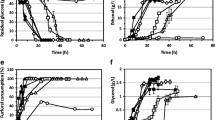Summary
Biotransformation of benzaldehyde and pyruvate to (R)-phenylacetyl carbinol bySaccharomyces cerevisiae was investigated in two-phase aqueous-organic reaction media. With hexane as organic solvent, maximum biotransformation activity was observed with a moisture content of 10%. Of the organic solvents tested, highest biotransformation activities were observed with hexane and hexadecane, and lowest activities occurred with chloroform and toluene. Biocatalyst samples from biphasic media containing hexane, decane and toluene manifested no apparent cell structural damage when examined using scanning electron microscopy. In contrast, cellular biocatalyst recovered from two-phase systems containing chloroform, butylacetate and ethylacetate exhibited damage in the form of cell puncturing after different incubation periods. Phospholipids were detected in reaction media from biocatalytic systems which exhibited cell damage in electron micrographs. Phospholipid release was much lower in the two-phase systems containing toluene or hexane or in 100% aqueous biocatalytic system.
Similar content being viewed by others
References
Bar, R. 1987. Phase toxicity in a water-solvent two-liquid phase microbial system. In: Biocatalysis in Organic Media (Laane, C., J. Tramper and M.D. Lilly, eds.), pp. 147–153. Elsevier, Amsterdam.
Brink, L.E.S. and J. Tramper. 1985. Optimisation of organic solvent in multi-phase biocatalysis. Biotechnol. Bioeng. 27: 1258–1269.
De Smet, M.J., J. Kingma and B. Withold. 1978. The effect of toluene on the structure and permeability of the outer cytoplasmic cell membranes ofE. coli. Biochim. Biophys. Acta 506: 64–80.
Deetz, J.S. and J.D. Rozzell. 1988. Enzyme-catalysed reactions in non-aqueous media. TIBTECH 6: 15–19.
Grunwald, J., B. Wirz, M. Scollar and A.M. Klibanov. 1986. Asymmetric oxido-reductions catalysed by alcohol dehydrogenase in organic solvents. J. Am. Chem. Soc. 108: 6732–6734.
Hocknull, M.D. and M.D. Lilly. 1987. The Δ-dehydrogenation of hydrocortisone byArthrobacter symplex in organicaqueous two-liquid phase environments. In: Biocatalysis in Organic Media (Laane, C., J. Tramper and M.D. Lilly, eds.), pp. 393–398, Elsevier, Amsterdam.
Ingram, L.O. and T.M. Buttke. 1982. Effects of alcohols on micro-organisms. Adv. Microbiol. Physiol. 25: 253–300.
Jackson, R.W. and J.A. De Moss. 1965. Effects of toluene onEscherichia coli. J. Bacteriol. 90: 1425–1520.
Kates, M. 1972. Techniques of Lipidology, Elsevier/North Holland, Amsterdam.
Kieslich, K. 1984. Introduction. In: Biotechnology 6a: Biotransformations (Kieslich, K., ed.), pp. 1–29, Verlag Chemie, Weinheim.
Klibanov, A.M. 1986. Enzymes that work in organic solvents. Chem. Technol. 16: 354–359.
Kockova-Kratochvilova, A. 1990. Yeasts, and Yeast-like Organisms, VCH Publishers, New York, NY.
Lilly, M.D. 1982. Two-liquid-phase biocatalytic reactions. J. Chem. Tech. Biotechnol. 32: 162–169.
Lilly, M.D. and J.M. Woodley. 1985. Biocatalytic reactions involving water-insoluble organic compounds. In: Biocatalysis in Organic Synthesis (Tramper, J., H.C. Van der Plas and P. Linko, eds.), pp. 179–192, Elsevier Science Publishers B.V., Amsterdam.
Lilly, M.D., A.J. Brazier, M.D. Hocknull, A.C. Williams and J.M. Woodley. 1987. Biological conversions involving waterinsoluble organic compounds. In: Biocatalysis in Organic Media (Laane, C., J. Tramper and M.D. Lilly, eds.), pp. 3–17, Elsevier, Amsterdam.
Long, A. and O.P. Ward. 1989. Biotransformation of aromatic aldehydes bySaccharomyces cerevisiae: investigation of reaction rates. J. Indust. Microbiol. 4: 49–53.
Long, A. and O.P. Ward. 1989. Biotransformation of benzaldehyde bySaccharomyces cerevisiae: Characterisation of the fermentation and toxicity effects of substrates and products. Biotechnol. Bioeng. 34: 933–941.
Long, A., P. James, P. and O.P. Ward. 1989. Aromatic aldehydes as substrates for yeast and yeast alcohol dehydrogenase. Biotechnol. Bioeng. 33: 657–660.
Nikolova, P. and O.P. Ward. 1991. Production ofl-phenylacetyl carbinol by biotransformation: product and by-product formation and activities of the key enzymes in wild-type and ADH isoenzyme mutants ofSaccharomyces cerevisiae. Biotechnol. Bioeng. 38: 493–498.
Nikolova, P. and O.P. Ward. 1992. Reductive biotransformation by wild type and mutant strains ofSaccharomyces cerevisiae in aqueous-organic solvent biphasic systems. Biotech. Bioeng. 39: 870–876.
Nurminen, T. and H. Suomalainen. 1973. Enzyme and lipid composition of cell envelope fractions fromSaccharomyces cerevisiae. Proc. Int. Spec. Symp. Yeasts, 3rd (Suomalainen, H., ed.), pp. 169–189, Alko, Helsinki.
Omata, T., N. Iwamoto, T. Kimura, A. Tanaka and S. Fukui. 1981. Stereoselective hydrolysis of dl-menthyl succinate by gel-entrappedRhodotorula minuta vartexensis cells in organic solvent. Eur. J. Appl. Microbiol. Biotechnol. 11: 190–204.
Schneider, L.V. 1991. A three-dimensional solubility parameter approach to non-aqueous enzymology. Biotechnol. Bioeng. 37: 627–638.
Servi, S. 1990. Baker's yeast as a reagent in organic synthesis. Synthesis: 1–25.
Silver, S. and L. Wendt. 1967. Mechanism of action of phenethyl alcohol: breakdown of the cellular permeability barrier. J. Bacteriol. 93: 650–656.
Teh, J.S. and K.H. Lee. 1976. Effects of n-alkanes onCladosporium resinae. Can. J. Microbiol. 20: 971–976.
Ward, O.P. and C.S. Young. 1990. Reductive biotransformations of organic compounds by cells or enzymes of yeast. Enz. Microbial Technol. 12: 482–493.
Ward, O.P. 1991. Bioprocessing, Van Nostrand Reinhold, New York.
Yamane, T. 1988. Importance of moisture content control for enzymatic reactions in organic solvents: a novel concept of ‘micro-aqueous’. Biocatalysis. 2: 1–9.
Yamane, T., H. Nakatani, E. Sada, A. Tanaka and S. Fukiu. 1979. Steroid bioconversion in water-insoluble organic solvents: Δ,1-dehydrogenation by free microbial cells and by cells entrapped in hydrophilic or lipophilic gels. Biotechnol, Bioeng. 21: 2133–2145.
Young, C.S. and O.P. Ward. 1991. Studies of the reductive biotransformation of selected carbonyl compounds by whole cells and extracts of baker's yeast,Saccharomyces cerevisiae. Biotech. Bioeng. 38: 1280–1284.
Zaks, A. and A.M. Klibanov. 1988. The effect of water on enzyme action in organic media. J. Biol. Chem. 263: 8017–8021.
Author information
Authors and Affiliations
Rights and permissions
About this article
Cite this article
Nikolova, P., Ward, O.P. Whole cell yeast biotransformations in two-phase systems: Effect of solvent on product formation and cell structure. Journal of Industrial Microbiology 10, 169–177 (1992). https://doi.org/10.1007/BF01569762
Received:
Revised:
Accepted:
Issue Date:
DOI: https://doi.org/10.1007/BF01569762




